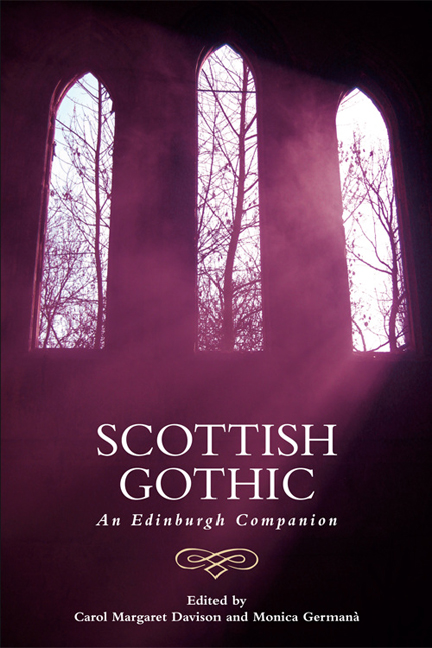Book contents
- Frontmatter
- Contents
- Acknowledgements
- 1 Borderlands of Identity and the Aesthetics of Disjuncture: An Introduction to Scottish Gothic
- 2 ‘The Celtic Century’ and the Genesis of Scottish Gothic
- 3 The Politics and Poetics of the ‘Scottish Gothic’ from Ossian to Otranto and Beyond
- 4 Robert Burns and the Scottish Bawdy Politic
- 5 Scottish Gothic Drama
- 6 Scottish Gothic Poetry
- 7 Calvinist and Covenanter Gothic
- 8 Gothic Scott
- 9 Gothic Hogg
- 10 ‘The Singular Wrought Out into the Strange and Mystical’: Blackwood's Edinburgh Magazine and the Transformation of Terror
- 11 Gothic Stevenson
- 12 J. M. Barrie's Gothic: Ghosts, Fairy Tales and Lost Children
- 13 The ‘nouveau frisson’: Muriel Spark's Gothic Fiction
- 14 Scottish Gothic and the Moving Image: A Tale of Two Traditions
- 15 New Frankensteins; or, the Body Politic
- 16 Queer Scottish Gothic
- 17 Authorship, ‘Ghost-filled’ Islands and the Haunting Feminine: Contemporary Scottish Female Gothic
- Notes on Contributors
- Index
1 - Borderlands of Identity and the Aesthetics of Disjuncture: An Introduction to Scottish Gothic
Published online by Cambridge University Press: 20 December 2017
- Frontmatter
- Contents
- Acknowledgements
- 1 Borderlands of Identity and the Aesthetics of Disjuncture: An Introduction to Scottish Gothic
- 2 ‘The Celtic Century’ and the Genesis of Scottish Gothic
- 3 The Politics and Poetics of the ‘Scottish Gothic’ from Ossian to Otranto and Beyond
- 4 Robert Burns and the Scottish Bawdy Politic
- 5 Scottish Gothic Drama
- 6 Scottish Gothic Poetry
- 7 Calvinist and Covenanter Gothic
- 8 Gothic Scott
- 9 Gothic Hogg
- 10 ‘The Singular Wrought Out into the Strange and Mystical’: Blackwood's Edinburgh Magazine and the Transformation of Terror
- 11 Gothic Stevenson
- 12 J. M. Barrie's Gothic: Ghosts, Fairy Tales and Lost Children
- 13 The ‘nouveau frisson’: Muriel Spark's Gothic Fiction
- 14 Scottish Gothic and the Moving Image: A Tale of Two Traditions
- 15 New Frankensteins; or, the Body Politic
- 16 Queer Scottish Gothic
- 17 Authorship, ‘Ghost-filled’ Islands and the Haunting Feminine: Contemporary Scottish Female Gothic
- Notes on Contributors
- Index
Summary
‘How can a “Scottish Gothic” be conceived?’ So asks Nick Groom in his provocative chapter in this collection, in the face of a historical, theoretical and political conundrum identified recently by other critics. In his article devoted to ‘Shakespeare, Ossian and the Problem of “Scottish Gothic”’, for example, Dale Townshend (2014) wrestles with the category of the Scottish Gothic given its union of seemingly irreconcilable terms whose yoking, he suggests, is counter-intuitive. According to Townshend, ‘Scotland's political and historical relationship to things “Gothic” … [is] a vexed and complicated issue’ that renders discussion of the anachronistic category of the ‘Scottish Gothic’ a fraught enterprise. One must adopt, he says, ‘a greater sensitivity to [the] political history’ of the eighteenth century (2014: 227), when the Goth and the Celt/Scot were generally positioned as discrete ethnographic categories.
The idea of a ‘Gothic Scotland’, however, did not prove difficult to conceptualise in the late eighteenth century and the early nineteenth when a Romanticised portrait of Scotland furnished the nation's most prevalent cultural image. As Ian Duncan astutely observes in regard to the politics of literary history, it was ‘Scotland's fate to have become a Romantic object or commodity’ rather than a site of Romantic production (Duncan et al. 2004: 2). Such an objectification was ironic given the existence of Scottish Enlightenment philosophy and its rationally fuelled preoccupations. That objectification was also, notably, expressed in two forms – in both the lighter and darker, more Gothic, shades of Romanticism. Despite the differences in these two manifestations, the Highlands served in both as a synecdoche for a Scotland that exemplified two primary attitudes towards ‘British’ history and rapid modernisation.
In the first, tourist literature of the era ‘deprecate[d] Scotland's modern developments’, imagining the Scottish nation as ‘immune to the passage of time’ (Grenier 2005: 136, 135). This immunity served an agenda grounded ‘in specific cultural needs and anxieties which emerged in both England and Scotland in the beginning of the industrial era’ (Grenier 2005: 11). In response to the advent of modernity and industrialisation, Scotland was nostalgically reconceptualised as a pre-modern domain of untouched, natural sublimity, a state from which Britain/England had, lamentably, fallen.
- Type
- Chapter
- Information
- Scottish GothicAn Edinburgh Companion, pp. 1 - 13Publisher: Edinburgh University PressPrint publication year: 2017

